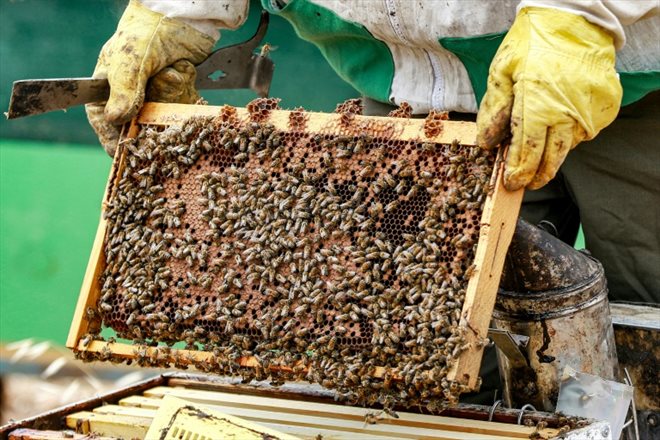Bees forage in cells of a hive in Irbid, northern Jordan, on June 20, 2023 (AFP/Khalil MAZRAAWI)
Derived from an immense diversity of flowering plants, citrus fruits, eucalyptus or maple, the honeys of Jordan are experiencing growing success, which keeps the country’s hives running at full capacity and arouses the vocations of beekeepers.
“The Covid period, in particular, had a positive impact on our activity. There was a strong demand for honey,” says Mutasim Hammad, a 48-year-old beekeeper who made his passion his main occupation after working to the Department of Public Security.
Wearing a white protective suit, he inspects his 80 hives located on a property in Irbid, 90 kilometers north of Amman.
According to the beekeeper, who sells around 400 kilograms of honey a year, “people have realized the value of locally produced honey, which is known for its anti-inflammatory properties and other health benefits.

A worker bee collects pollen and nectar from flowers in Irbid, northern Jordan, on June 20, 2023 (AFP/Khalil MAZRAAWI)
The Kingdom of Jordan prides itself on its rich diversity of honeys, including 19 different types. “We have around 2,500 flowering plants,” said Mohammad Rababaa, director of the Jordan Beekeepers Association.
“This diversity distinguishes Jordanian honey and means that its therapeutic and nutritional value should be better than that of other types of honey,” he said. He cites the example of maple honey, which is slightly bitter and has “a very high level of phenolic compounds and antioxidants compared to other types of honey”.
– More than 4,000 beekeepers –
Since the pandemic, “the demand for locally produced honey has clearly increased,” confirms Mr. Rababaa, professor of natural resources and environment at the Jordanian University of Science and Technology.

Mohammad Khatib inspects cells of a beehive in Irbid, northern Jordan, on June 20, 2023 (AFP/Khalil MAZRAAWI)
For him, the number of beekeepers “is actually more than 4,000”, much more than the approximately 1,400 officially listed in Jordan.
They produce between 700 and 800 tons a year, or about 70% of the country’s annual needs, he says. “We are very close to self-sufficiency,” underlines Mr. Rababaa, who even proposes stopping imports.
Another enthusiast, Mohammad Khatib, 49, says the pandemic and lockdown have “gave him enough time to learn about bees and take care of them”.
A French teacher at al-Bayt University, he operates about fifteen beehives in his garden, which provide him with a significant additional income.

A beekeeper holds cells of a hive in Irbid, northern Jordan, on June 20, 2023 (AFP/Khalil MAZRAAWI)
“People are looking for quality honey” and some customers place their orders a year in advance, he says. Jordanian honey sells for between 15 and 30 dinars ($19 to $39) per kilogram, depending on the type.
According to Mohammad Rababaa, the economic benefits “are not limited to honey, because the bee also produces pollen, royal jelly, wax, propolis and bee venom, which is used in the composition of many therapeutic compounds”. Not to mention the pollination of plants, with almost unlimited effects on the ecosystem.
While the beekeeping sector generates around 25 million euros per year, “the indirect value of crop pollination exceeds 100 million dollars (90 million euros)”, underlines Mr. Rababaa.
© 2023 AFP
Did you like this article ? Share it with your friends with the buttons below.




